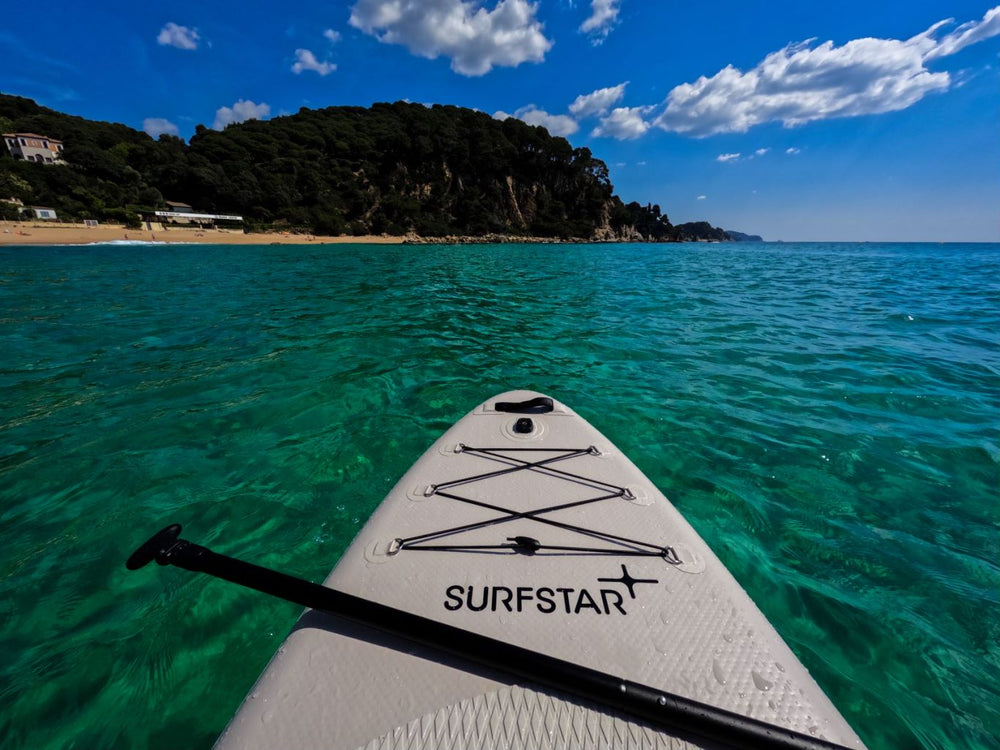How Are Inflatable Paddle Boards Made?
Over the last few years inflatable paddle boards have become increasingly popular. As they are inflatable, they can be easily stored and transported without you needing to have a big garage or roof racks. They are a great option for many people, especially beginners, as they are strong, easy to store, and cheaper than other types of paddle boards. There are several ways to construct a paddle board, and each brand may have a slightly different method of construction, but the five main methods are Single Skin, Stringer, Glued Double Layer, Woven Fusion Double Layer and Laminated Double Layer.
Single Layer Construction
As with all the construction methods, the single layer technology begins with the drop stitch. This process involves joining two pieces of polyester woven support fabric with thousands of fine polyester threads which are sewn by up to 400 needles at a time. Each needle sews a continuous and evenly spaced thread back and forth between the two pieces of fabric which locks them together and makes them incredibly strong. The drop stitched fabric alone is not airtight, so a liquid PVC layer is then used to cover it which creates an airtight seal once it has dried. This is the single layer.
The main advantages of this construction method are weight and price. As it uses less material, the paddle board is very lightweight and can be cheaper than previous double layer SUPs(as the materials got better over the years in the industry).
Stringer Construction
Boards that are made with stringer technology are made just like single layer paddle boards (drop stitch plus a single layer of PVC), but they have the addition of a ‘stringer’. The idea of a ‘stringer’ comes from the traditional way in which surfboards are made, where a thing ‘stringer’ increases the rigidity of the board. Inflatable SUPs use a wide PVC strip that is glued to the center of the board to achieve a similar effect.
This method increases the rigidity of the board as well as reducing flex when you stand on the board and paddle. The addition of the stringer creates a more solid board that grants the user a better paddling experience. Due to it being only a small addition, the board is still lightweight, and it does not cost much more than a single layer board. However, if you are looking for even more rigidity then a doubly layer construction may be a better option.
Fusion Double Layer Construction
For this type of construction, the drop stitched fabric is not covered in PVC, it is instead covered with adhesive and then a reinforced second later is laminated onto the board. This process removes any cosmetic wrinkles or bubbles from the board's surface and makes it slightly stiffer.
The key advantages of boards made in this way are their increased stiffness, durability and strength. Also, these boards are up to 25% lighter than those with a standard double layer construction, which amounts to a saving of around 2kg in weight. Furthermore, these boards are roughly 25-30% stiffer than boards manufactured with glued double layer construction. They can be more expensive than other SUPs.
Woven Fusion Double Layer Construction
Recently introduced into the world of SUP manufacturing, the woven process creates an even stiffer and lighter board. Instead of the traditional drop stitch method, the yearn is sewn using an innovative woven method which provides more structure and uses less yarn. The board is then covered with a laminated PVC layer.
Despite its increased cost, this board is a great option for advanced paddle boarders. The woven process renders the board even lighter and stiffer, and there are no cosmetic wrinkles or bubbles on the board’s surface. The board maintains its shape really well, and is still very lightweight, so it is easily transportable, which can be great for those who struggle carrying heavier things.
Glued Double Layer Construction
Glued double layer construction is generally only used for boards that need to be very strong, although it was previously used more widely. Beginning with a single layer board (drop stitched fabric covered in a PVC layer), a second PVC layer is then glued to the board. This differs from fusion double layer construction as the layer is glued not laminated, and from boards with stringer technology as the PVC coats the entire board, not just a center strip.
The primary advantage of this board is its increased strength, so this technology is typically used for specialist boards. However, these boards are heavier, and the technology is rather outdated, so boards are not commonly made like this anymore.
As you can see, there are many different ways to make stand up paddle boards, and each method will give you a slightly different board and therefore a slightly different paddle boarding experience. The durability, stiffness and cosmetic appearance of each board varies depending on how it is constructed, as well as the cost. By spending some time considering what you need the board for, you will be able to work out exactly which kind of inflatable paddle board is right for you.





Leave a comment